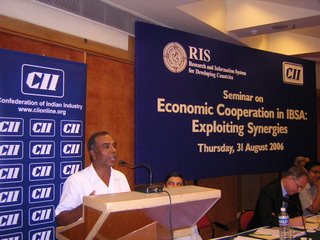
In my talk, I took the audience beyond the markets and behind the statistics. I talked about the people, their colour and mindset and the synergies between their core competence and convergence of their aspirations.
IBSA is a "cafe -con- leite" ( coffee- with- milk ) alliance. The people of the three countries have the common coffee- with- milk skin color. some have more milk and others have less!. In Brasil, cafe and milk have mixed historically blending beautifully in a spectrum from blonde to dark. Brazil has more people of African origin than South Africa's 47 million population. In India it is premixed and cafe and milk is not available separately. In South Africa, it is still separately served. This opened up opportunity to tell some jokes...
The mindset of these three countries have undergone a paradigm shift in recent years. In India the bz mindset has changed from the "Fear of East India company" to the " Pride of Mittal steel". The Brazilians have become confident and assertive on the basis of their solid democracy and sound economy and regional leadership. South Africans have given pride and dignity to Africa. It is this new mindset of the three peoples which have lead to the IBSA partnership. This would not have been possible under the old mindset , even ten years ago.
The USP of India is IT and human resources. IT has empowered India and the Indians. It has ignited young Indians to nurture audacious ambitions to connect and compete with the world and even think of conquering. USP of Brasil is Agribusiness. With vast areas of fertile land and water resources Brazil is set to become an agri superpower. The USP of South Africa is mining. If there is one country which is most loved by Indian women.. it is south africa.. so much gold and diamonds!! Of course, the Indian men will vote for Brazil... some more jokes...oops can't be put here.
The seminar was chaired by Mr Arjun Sengupta. The other speakers included Dr Nagesh of RIS, Vishwanath of CII and Veena Jha of Unctad. It was organised by CII as a curtain raiser before the IBSA summit in Brasilia on 13 Sept 06.





